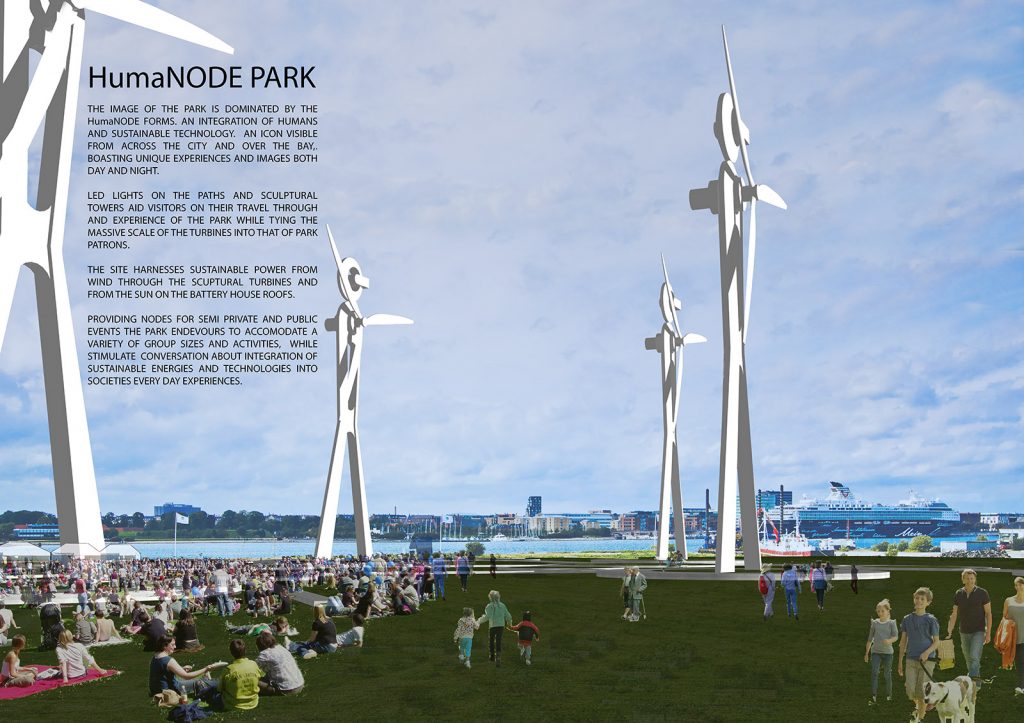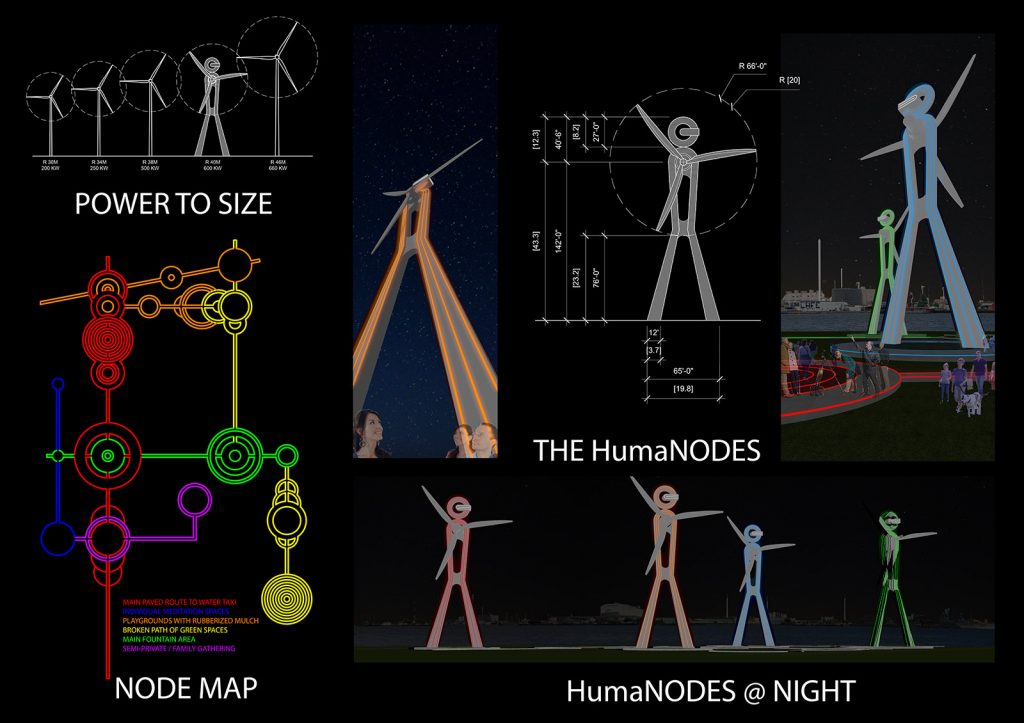
HumaNODE Park
The Image
The image of the park is dominated by the HumaNODE Forms; An integration of humans and sustainable technology. Creating an icon visible from aross the city and over the bay. The Park boasts unique experiences and icons both day and night.
HumaNODE Park’s defining characteristic is a group of wind turbines that are sculpted into human forms. They represent the coming together of human kind and renewable energy sources. Anyone can become a HumaNODE by living a sustainable lifestyle and capitalizing on the renewable resources and practices that new technologies afford society. The park visitors should be impressed, but not overwhelmed by the size of the sculptures and the impact that a single person can have on the environment and societal behaviors.
A typical city park during the day, filled with artist and farmers markets, children playing and water taxis coming and going. At night the park transforms and gives a feeling of truly advancing technology all around HumaNODE Park.

LED Lights on the paths and sculptural towers aid visitors on their travel through and experience of the park, while tying the massive scale of the turbines into that of the park patrons. The colors indicate functional relationships:
- RED: main paved route to Water Taxi
- BLUE: individual / small group meditation spaces
- ORANGE: playgrounds with rubberized mulch
- YELLOW: broken / winding path of manicured green spaces
- GREEN: main fountain area
- VIOLET: semi-private / family gathering
The site harnesses sustainable power from wind through the sculptural turbines and from the sun on the batteryhouse roof.
Providing Nodes for semi-private and public events the park endeavors to accommodate a variety of group sizes and activities, while stimulating conversation about the integration of sustainable energies and technologies into society’s everyday experiences

The NODES
Multiple nodes combine into (16) function areas ranging from picnic areas with artificial turf (allowing year round use), to playgrounds with soft rubberized flooring. Meditation spaces for intimate two and four person groups as well as a large reflecting pool off the main path for individuals to have a group setting for quiet public interaction line one edge of the peninsula. Large communal areas for local artists and farmers markets dot the main path to the water taxi. In all, the nodes are sized to accommodate groups as small as two up to functions with a few hundred people.
LED light rings at the nodes and edges of the sidewalks give the feeling of integrated technology at the ground level as well as climbing the HumaNODES.
The park will have trash compactors available for general waste, recycling and organic waste to help reduce the parks carbon footprint. Less waste volume means fewer removal days and creates public awareness of small trash compaction, recycling and the differences between compost and general waste.
Finally, benches with high backs facing the water will shield the visitors from the wind while still allowing the turbines to operate.
The HumaNODES
LED lights reveal the image of the park, highlighting the HumaNODE form and our integration with technology. As the sun sets the whole character of the park evolves. LED’s flash on and the whole park becomes alive again. Yaw control is in the foundations of the HumaNODES and allows the entire structure to rotate with the wind. The turbines are skinned in white metal with clean seams. (4) 66’ diameter turbines will create as much as 7,350 MWH per year. (600 KW x 365 days x 24 hours x 35% = 1840 x 4 = 7350 MWH)
The Battery Houses
Solar power is gathered on the roof of the battery houses. The panels are raised a few feet off of the actual roof and create a single skewed plane. The airspace and shade will help to cool passively cool the batteries and their housing. Integration of solar into the shading structure allows multiple renewable energies to be harnessed. The form of the shading planes on the buildings is drawn from the propellers of wind turbines, giving a nod to the other renewable source on site.
Environmental Impact
HumaNODE Park endeavors to be as environmentally sensitive as possible while gathering renewable energies from the environment. Birds may be effected by the turbines, but there are numerous others already installed around the site and throughout the region. Separation of compost and waste will also improve the parks impact. Micro wind patterns may also be adversely affected. Incorporation of recycled tires for rubber mulch and pervious pavement will allow the site to create less runoff than with the same areas traditionally paved.
